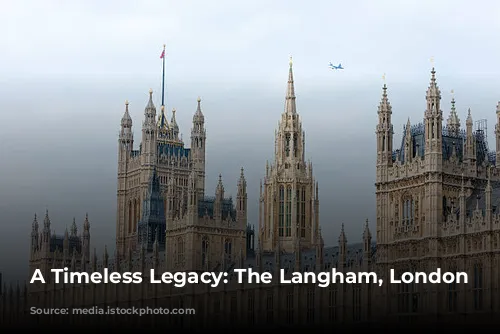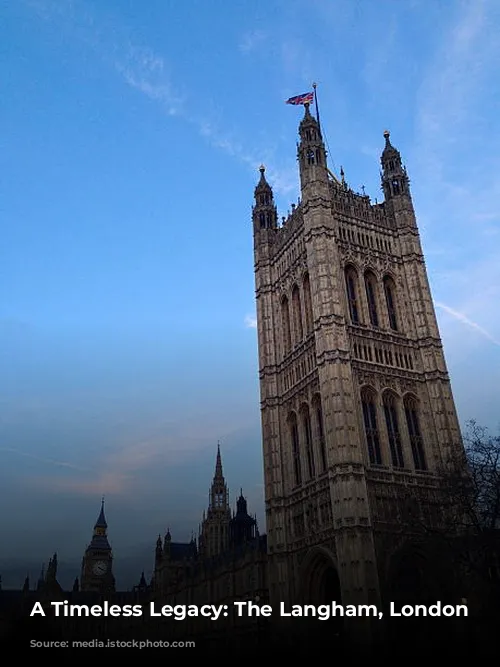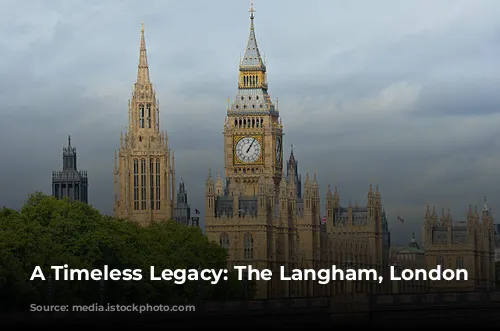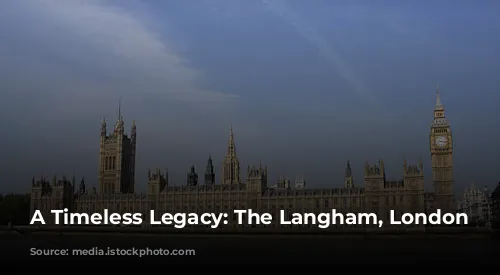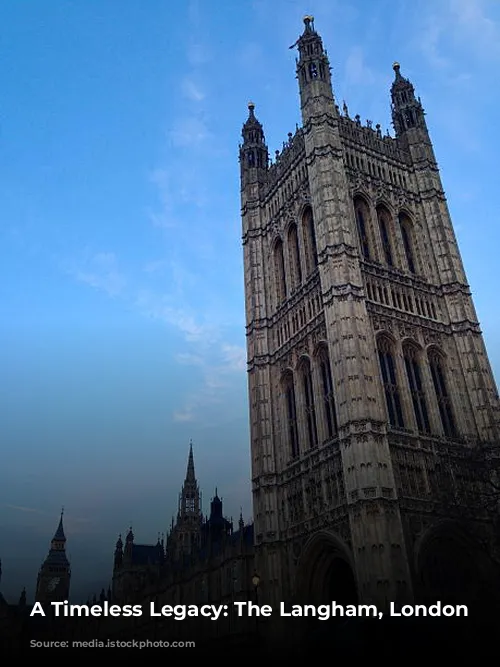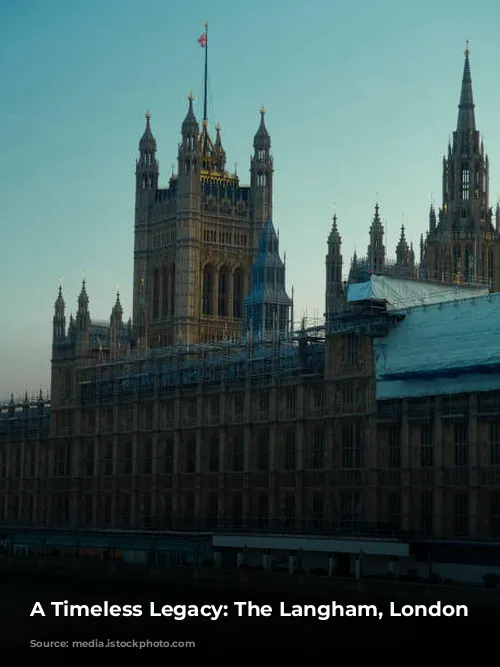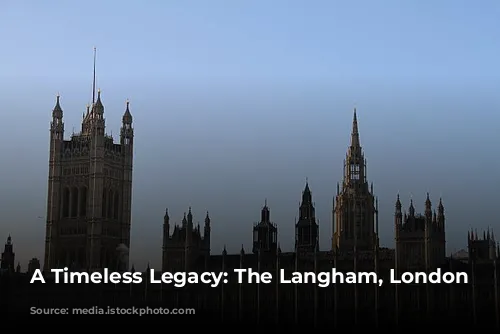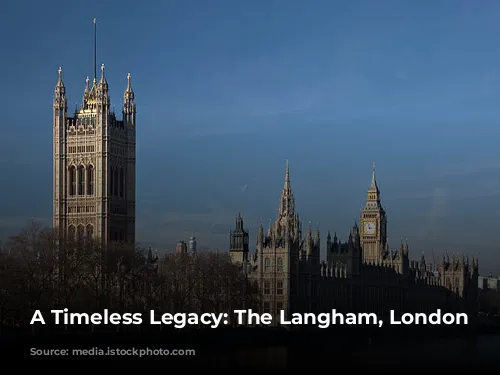In the heart of London, a grand edifice stands tall, embodying the elegance and grandeur of a bygone era. The Langham, London, a five-star hotel nestled in the Marylebone district, holds a place of historical significance, its imposing presence overlooking Langham Place and facing the verdant expanse of Regent’s Park.
This iconic landmark was a product of Victorian ambition, its construction between 1863 and 1865 a testament to the ingenuity of architect John Giles and the building prowess of the Lucas Brothers. The staggering cost of £300,000, a colossal sum for the time, equated to approximately £36,230,425 in today’s currency. At its grand opening on June 10, 1865, the Langham stood as the city’s most opulent and technologically advanced hotel, boasting an impressive array of amenities, including an unprecedented 100 water closets, 36 luxurious bathrooms, and the first hydraulic lifts ever seen in England. This audacious feat of engineering was unveiled to the world by none other than the Prince of Wales, adding an air of royalty to the occasion.
A Gathering Place for the Elite
The Langham’s early years were marked by a dramatic shift in fortune. After the original company faced financial difficulties, a new management team took over, acquiring the hotel for a fraction of its construction cost. The hotel quickly flourished, attracting a diverse and distinguished clientele, including luminaries from the world of politics, entertainment, and business.
The year 1867 saw the appointment of James Sanderson, a former Union Army officer, as the general manager. Sanderson’s leadership brought about a surge in American guests, with notable figures such as Mark Twain and the legendary financier Hetty Green gracing its halls. But the Langham’s allure extended far beyond the shores of America. It welcomed dignitaries like Napoleon III, the enigmatic Oscar Wilde, and celebrated composers such as Antonín Dvořák, Arturo Toscanini, and Jean Sibelius, their presence adding a layer of artistic brilliance to the hotel’s legacy. The installation of electric light in the entrance and courtyard in 1879, a groundbreaking achievement for the time, further solidified the Langham’s reputation as a pioneer of innovation.
The literary world also found its way into the Langham’s grand chambers. Arthur Conan Doyle, the creator of the iconic Sherlock Holmes, set two of his most famous stories, “A Scandal in Bohemia” and “The Sign of Four,” within its walls, immortalizing the hotel’s allure in fictional narratives.
A Century of Royal Patronage and Resilience
The Langham continued to hold its place as a favored destination for the elite throughout the 20th century. Royalty graced its corridors, with the likes of Diana, Princess of Wales, choosing the Langham as a sanctuary, while influential figures like Winston Churchill and Charles de Gaulle added their presence to the hotel’s illustrious guest list. The Langham’s allure was undeniable, drawing in a constellation of stars, including Noël Coward, the enigmatic Wallis Simpson, the legendary cricketer Don Bradman, Emperor Haile Selassie of Ethiopia, and Japanese pop sensation Ayumi Hamasaki.
The Langham, like many institutions, faced its share of challenges. The Great Depression cast a shadow over its operations, prompting the owners to consider selling the property to the BBC. Although the BBC did acquire a presence in the neighborhood, building Broadcasting House across Portland Place, the Langham continued to stand strong.
World War II brought a different kind of adversity. The Langham was pressed into service by the British Army, only to be struck by bombs, forcing its closure. After the war, the BBC took temporary residence, eventually purchasing the hotel outright in 1965. The BBC’s association with the Langham, however, was not without its intrigue. One of their employees, Guy Burgess, a key member of the Cambridge Five spy ring, who leaked secrets to the Soviet Union, had an infamous run-in with the hotel’s security. Burgess, unable to access his room one night, resorted to using a fire extinguisher to force his way in, leaving behind a trail of mischief and intrigue.
Rebirth and Renewal
The BBC’s ownership of the Langham marked a period of transformation. The Palm Court, once a gathering place for the elite, was converted into a reference library, and the restaurant became a staff bar and refreshment room. In 1980, the BBC’s ambitious plan to demolish the hotel and replace it with a new office development designed by the renowned architect Norman Foster was met with resistance and ultimately failed.
The Langham’s fate took a turn in 1986 when the BBC sold it to the Ladbroke Group, a move that signaled a return to its former glory. After an extensive £100 million refurbishment, the hotel reopened in 1991 as the Langham Hilton, once again becoming a beacon of elegance and hospitality.
In 1995, Hong Kong-based Great Eagle Holdings acquired the Langham, marking a new chapter in its history. The new owners embarked on a series of renovations, expanding the hotel’s footprint and restoring its grandeur to its original splendor. This extensive refurbishment, completed between 1998 and 2000, was followed by another in 2004, concluding in 2009 with an estimated cost of £80 million. The Langham’s restoration was a labor of love, meticulously reviving its original character and architectural features.
Great Eagle Holdings’ commitment to the Langham extended beyond its own walls. They recognized the brand’s enduring appeal and embarked on a strategic expansion, creating Langham Hotels International, a subsidiary that brought the Langham experience to hotels around the world.
A Modern Icon
The Langham today is a testament to its enduring legacy. It stands as a five-star hotel, boasting 380 rooms, a beautifully restored Palm Court, where the tradition of afternoon tea continues to enchant guests, a state-of-the-art business center, and 15 versatile function rooms, including the magnificent Grand Ballroom.
In 2024, the Langham is set to unveil a new culinary experience, “Mimosa,” a restaurant replacing The Landau, while the adjacent Wigmore, a British tavern by the renowned chef Michel Roux Jr., offers a taste of traditional British gastronomy. The hotel also boasts the popular “The Good Front Room,” a long-term residency by Dom Taylor, the winner of the “Five Star Kitchen” TV show. The Langham’s bar, Artesian, is a cocktail lover’s paradise, offering a sophisticated setting for private dining.
The Langham’s commitment to culinary excellence is further exemplified by the 2019 launch of its cookery school, Sauce by The Langham, providing guests with the opportunity to delve into the world of culinary arts.
The Langham’s storied past extends beyond its walls, woven into the fabric of literature and film. A green plaque, unveiled in 2010, marks the location of a historic meeting in 1889 between Oscar Wilde, Arthur Conan Doyle, and Joseph Marshall Stoddart, a gathering that led to the creation of literary masterpieces such as “The Sign of Four” and “The Picture of Dorian Gray.”
The Langham’s cinematic presence includes a cameo in the James Bond film “GoldenEye,” its grand entrance serving as a stand-in for Saint Petersburg’s Grand Hotel Europe. The Langham has also been featured in “Wonderland,” a film directed by Michael Winterbottom, “Winning London,” a made-for-TV movie starring Mary-Kate and Ashley Olsen, and “Garfield: A Tail of Two Kitties.” The Langham’s restaurant serves as the primary setting for the culinary drama “Burnt,” starring Bradley Cooper, highlighting the hotel’s enduring appeal as a backdrop for captivating stories.
The Langham’s legacy continues to unfold, its presence gracing the pages of literature and the screens of television. The Palm Court at the Langham is now the setting for the reality TV cooking show, “Five Star Chef,” showcasing the hotel’s enduring allure as a venue for entertainment and culinary artistry.
From its grand Victorian beginnings to its modern-day elegance, The Langham, London, has stood the test of time. It remains a beacon of hospitality, an embodiment of luxury, and a timeless testament to the city’s enduring allure.
